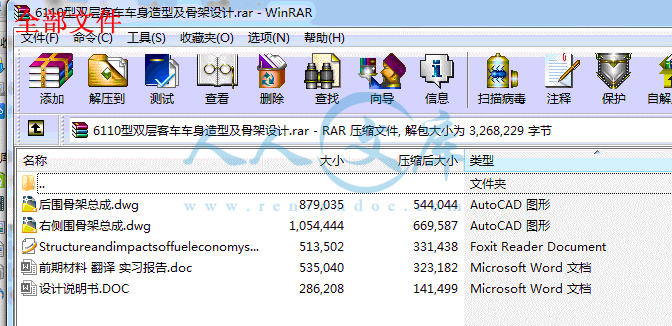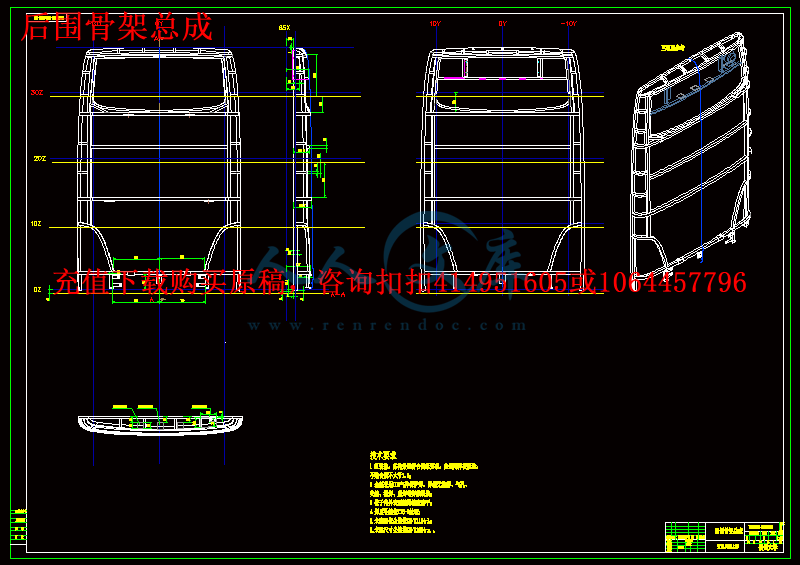摘 要
6110型双层客车车身造型相当重要, 它直接影响整车的视觉效果。文章简要介绍我国客车造型的发展和现状; 较详细说明客车整体、局部造型及内饰技术和在造型中应注意的一些问题, 并展望我国客车造型未来的新局面。
6110型双层客车车身设计是设计过程中非常重要得一个环节。车身根据其承载形式可分为承载式,非承载式和半承载式。按结构划分,整个骨架分为前围、后围、左侧侧围和顶盖五大部分。
本次毕业设计主要采用auto CAD软件设计发动机后置的城市中型客车车身骨架的设计过程。文章主要阐述了车身骨架设计原则及依据,介绍了各种车身骨架结构形式,给出了车身骨架设计过程结构与尺寸,并对车身骨架进行了车身骨架的受载分析和强度分析,论了车身骨架的制造工艺.为了满足车身强度要求,车身骨架采用CO2气体保护焊焊接。
关键词:6110型双层客车 造型 设计 骨架 承载式 受载 焊接
ABSTRACT
The importance of busmodeling directly influences the bus vision . Th is article briefly introduces Ch inese busmodeling development and p resent situation,more detailedly describes the w hole and partial area modeling, trim tech2nology and some questions needing attention. It also look s forw ard to the future new situation of Ch inese busmodel2ing.
The 6110body design is an automobile design process Central Africa constant weight fine link.The automobile body acts according to its load bearing form to be possible to divide into the load bearing type, non-load bearing type and half load bearing type. the side encircles with the roof panel five major parts.
Mainly I use auto for this graduation project the CAD software design engine postpositioned city medium passenger train body frame the design process.The article mainly elaborated the body frame principle of design and the basis.Introduced each kind of body frame structural style, has given the body frame design process structure and the size, and carried on the body frame to the body frame to carry the analysis and the intensity analysis, elaborated the body frame manufacture craft.In order to satisfy the skeleton the intensity request, the entire body frame uses the CO2 shielded welding welding.
Key word: 6110Automobile body Modeling Carcase Design Skeleton Load bearing Welding
目录
第一章 绪论5
1.1课题分析及设计定位5
1.1.1 国内外客车的发展现状和对我国长途客车要求的分析5
1.1.2 设计基本思路的定位8
1.2我国客车工业的发展8
1.2.1 我国的客车发展现状8
1.2.2 客车制造工艺的发展 10
1.3国外客车的发展概况及车身造型 1.3.1 车身造型 12
1.3.2 综合性能
1.3.3 新技术13
1.3.4 新材料13
1.3.5 新工艺14
第二章 AUTO CAD 在6110型双层客车设计上的应用14
2.1前言15
2.2 AUTO CAD绘图软件介绍15
2.2.1 AUTO CAD绘图软件包的特性15
2.2.2 AUTO CAD系统的设备组成15
2.2.3 计算机15
2.2.4 外部设备15
2.3 用AUTO CAD 设计提高绘图速度的方法16
2.3.1 建立常用符号库16
2.3.2 建立标准件和标准型材库16
2.3.3 开发编辑命令17
2.3.5 建立总成图形库17
2.3.6 相关总成直接调用17
2.4 6110型双层客车应用AUTO CAD的设计优点18
第三章 6110型双层客车车身骨架设计原则和依据19
3.1 车身骨架的作用19
3.2本课题6110型双层客车骨架的设计原则19
3.3 本课题骨架的设计依据21
第四章 各种车身骨架结构形式分析22
4.1 6110型双层客车客车车身结构型式分析22
4.1.1按用途分类22
4.1.2按承载形式分类22
第五章 6110型双层客车车身骨架主要尺寸及结构形式确定26
5.1.车身骨架材料及型式26
5.2结构形式设计26
5.2.1左右侧围骨架设计与分析26
5.2.2 前、后围骨架设计与分析28
5.2.3 顶盖骨架设计与分析29
第六章 6110型双层客车车身骨架强度计算31
6.1车身结构受载分析31
6.2车身骨架强度计算32
6.2.1车身扭矩计算32
6.2.1计算公式36
第七章 6110型双层客车车身骨架制造工艺过程40
7.1 车身骨架的制造40
7.1.1矩形管的剪切切断40
7.2 6110型双层客车车身骨架五大片的合理划分41
7.3 6110型双层客车骨架的焊接工艺41
7.3.1 CO2气体保护焊41
7.3.2 6110型双层客车车身骨架五大片的组焊43
7.3.3 整车骨架联装组焊43
第八章 设计评价分析45
8.1存在的不足45
8.2改进方法45
结 束 语46
致 谢47
第一章 绪论
1.1课题分析及设计定位
1.1.1 国内外客车的发展现状和对我国长途客车要求的分析
当今客车的发展日新月异。例如,每年的德国法兰克福世界客车展览会上均汇集了世界客车领先企业的顶尖产品(德国的奔驰公司、尼奥普兰公司、曼公司,瑞典的沃尔沃公司、斯堪尼亚公司等);他们今天展示的全新造型的新产品极有可能就是明天客车外形的发展趋势。21 世纪对各种大、中型客车发展的希望是,在安全、方便、快捷的基础上更舒适和环保,并且充分体现以人为本的要求;具体表现在,除了“三低”(低污染、低消耗、城市客车低地板)和“三高”(高比功率——良好的动力加速性、高安全可靠性、高舒适性)以及外观优美、座位合适、价格适中外,在综合性能方面还应该有新的发展趋势;其中包括,新技术(控制整车的各个方面均由计算机技术实现,代用燃料发动机,为改善制动性能和操纵性能而形成的标准设备,装有永磁式缓速器的传动系统)、适应市场要求的新材料,新工艺(提高车身涂装工艺标准,逐步实现产品生产的模具化)。
欧洲是世界商用车的中心,拥有诞生世界第一客车的荣耀;在客车诞生 100 多年的今天,依然引领客车工业的方向——从发动机到变速箱、从底盘到车身;其 ECE R66 安全标准正成为世界标准。欧洲大型客车的主要特点是,全承载式车身,发动机功率大、扭矩高,且发动机转速呈下降趋势(当前用柴油机的最大转速平均为 1190r/min);其中,约 80%以上的产品采用空气悬架。这使客车的行驶速度加快,加速性、爬坡性、可靠性增强,经济性、环保性能、安全性更好;侧倾刚度、行驶平顺性、舒适性均有明显提高。目前,它的技术先进性主要表现在以下 4 个方面。
①节能技术——采用铝、镁合金、塑料,减小客车车身质量;研制风阻系数小的客车外形,尽可能地降低客车的空气阻力;设计使用天然气、甲醇、乙醇等新能源的客车。
②环保技术——改用无铅汽油和电子喷射式汽油机;安装废气处理装置;客车零部件的材料采用可回收利用的。
③安全技术——应用计算机仿真技术预示客车多方位碰撞的安全性、翻车时顶盖的强度和刚度、保证乘车人员生存空间的车身结构等;外,增加安全附加装置和采用高新技术产品,如安全带、安全气囊、防抱死制动统(ABS)、加速防滑系统(ASR)、自动差速锁装置(ASD)、缓速器。
④底盘技术——采用三段式底盘(半承载式)和无车架式底盘(承载式),使底盘布置形式呈“柔性化”,以适应各种匹配要求。
自20 世纪 70 年代以来,中国客车经历了近 40 年的发展;引以自豪的是,国产客车基本占据全部国内客车市场,没有出现国外客车大批量拥入中国市场的现象。据统计,近年来的客车年产销量均在 8 万多辆,2005 年的全国从事旅游运营的大中型客车达 60 多万辆。国产客车的各大型龙头企业已具有相当先进的设备和工艺方式、完善的管理经验和与之配套的营销网络,在设计、研制、生产方面具备了一整套完善的技术力量保障措施,能够研制和生产不同档次、不同类型的客车、客车底盘、总成;例如,厦门金龙、郑州宇通、苏州金龙、扬州亚星等大型客车厂家。国产客车能够取得如此成就,其主要原因在于,国产客车在经历了改装、仿制、技术引进、中外合资的历程后,使中国客车工业的整体水平得到极大的提高和客车的整车质量得到稳步发展,缩小了与国外先进客车的差距。



 川公网安备: 51019002004831号
川公网安备: 51019002004831号